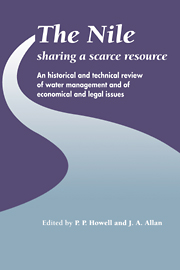 The Nile: Sharing a Scarce Resource
The Nile: Sharing a Scarce Resource Book contents
- Frontmatter
- Contents
- Preface
- List of Contributors
- Orthography
- Units and Conversion Factors
- Introduction
- I Environmental history of the Nile and its management
- II Nile management and factors affecting future management
- III Future utilisation of Nile waters
- 8 Future irrigation planning in Egypt
- 9 Future water development planning in the Sudan
- 10 Irrigation and hydro-power potential. Water needs in Uganda, an overview
- 11 The integrated development of Nile waters
- 12 The control of the swamps of the southern Sudan: Drainage schemes, local effects and environmental constraints on remedial development
- 13 Water balance of the Bahr el Ghazal swamps
- IV Economic, international and legal issues
- Index
13 - Water balance of the Bahr el Ghazal swamps
Published online by Cambridge University Press: 05 February 2012
- Frontmatter
- Contents
- Preface
- List of Contributors
- Orthography
- Units and Conversion Factors
- Introduction
- I Environmental history of the Nile and its management
- II Nile management and factors affecting future management
- III Future utilisation of Nile waters
- 8 Future irrigation planning in Egypt
- 9 Future water development planning in the Sudan
- 10 Irrigation and hydro-power potential. Water needs in Uganda, an overview
- 11 The integrated development of Nile waters
- 12 The control of the swamps of the southern Sudan: Drainage schemes, local effects and environmental constraints on remedial development
- 13 Water balance of the Bahr el Ghazal swamps
- IV Economic, international and legal issues
- Index
Summary
Introduction
The Bahr el Ghazal swamps are unusual in that they are fed by a number of seasonal tributaries whose flows are almost entirely lost within the basin. The swamps have not been studied in recent years since the analysis by Chan and Eagleson (1980) and more flow records are now available. A water balance model has been developed for the Sudd (Sutcliffe & Parks, 1987) and subsequently applied in a comparison of other African wetlands (Sutcliffe & Parks, 1989). The application of similar analysis to the Bahr el Ghazal swamps serves to compare their regime with that of the Sudd or Bahr el Jebel swamps.
Previous studies
Previous accounts of the Bahr el Ghazal basin are included in The Nile Basin, Vols I & V (Hurst & Phillips, 1931, 1938), JIT (1954), SDIT (1955), and Chan & Eagleson (1980). Brief descriptions of these studies are followed by discussion of the main topics relevant to this study.
The Nile Basin, Vol I, contains descriptions of the topography of the basin and individual rivers, illustrated by a number of photographs. The standard pattern of the Bahr el Ghazal tributaries is that of rapid runoff from an elevated perimeter along the Nile-Congo divide with good drainage and some rapids, through a zone where the river meanders between alluvial banks in a defined and widening valley into a zone of unrestricted flooding over clay plains (SDIT, 1955, see also Chapter 12).
- Type
- Chapter
- Information
- The Nile: Sharing a Scarce ResourceA Historical and Technical Review of Water Management and of Economical and Legal Issues, pp. 281 - 298Publisher: Cambridge University PressPrint publication year: 1994
- 1
- Cited by


